Related Research Articles

A military engineering vehicle is a vehicle built for the construction work or for the transportation of combat engineers on the battlefield. These vehicles may be modified civilian equipment or purpose-built military vehicles. The first appearance of such vehicles coincided with the appearance of the first tanks, these vehicles were modified Mark V tanks for bridging and mine clearance. Modern military engineering vehicles are expected to fulfill numerous roles, as such they undertake numerous forms, examples of roles include; bulldozers, cranes, graders, excavators, dump trucks, breaching vehicles, bridging vehicles, military ferries, amphibious crossing vehicles, and Combat engineer section carriers.

Continuous track is a system of vehicle propulsion used in tracked vehicles, running on a continuous band of treads or track plates driven by two or more wheels. The large surface area of the tracks distributes the weight of the vehicle better than steel or rubber tyres on an equivalent vehicle, enabling continuous tracked vehicles to traverse soft ground with less likelihood of becoming stuck due to sinking.

Excavators are heavy construction equipment consisting of a boom, dipper, bucket and cab on a rotating platform known as the "house". The house sits atop an undercarriage with tracks or wheels. They are a natural progression from the steam shovels and often mistakenly called power shovels. All movement and functions of a hydraulic excavator are accomplished through the use of hydraulic fluid, with hydraulic cylinders and hydraulic motors. Due to the linear actuation of hydraulic cylinders, their mode of operation is fundamentally different from cable-operated excavators which use winches and steel ropes to accomplish the movements.

A bulldozer or dozer is a large, motorized machine that travels on continuous tracks or large tires and is equipped with a metal blade to the front for pushing material: soil, sand, snow, rubble, or rock during construction or conversion work. When needed, a hook-like device can be mounted on the rear to loosen dense materials.
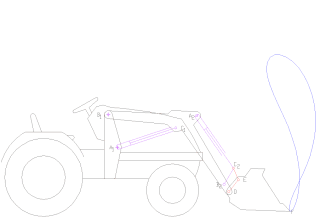
A loader is a heavy equipment machine used in construction to move or load materials such as soil, rock, sand, demolition debris, etc. into or onto another type of machinery.
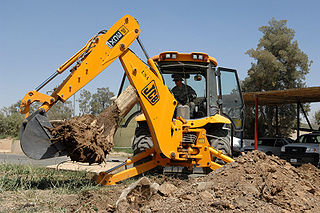
A backhoe—also called rear actor or back actor—is a type of excavating equipment, or digger, consisting of a digging bucket on the end of a two-part articulated arm. It is typically mounted on the back of a tractor or front loader, the latter forming a "backhoe loader". The section of the arm closest to the vehicle is known as the boom, while the section that carries the bucket is known as the dipper, both terms derived from steam shovels. The boom is generally attached to the vehicle through a pivot known as the king-post, which allows the arm to pivot left and right, usually through a total of 180 to 200 degrees.
A backhoe loader, also called a loader backhoe, digger in layman's terms, or colloquially shortened to backhoe within the industry, is a heavy equipment vehicle that consists of a tractor-like unit fitted with a loader-style shovel/bucket on the front and a backhoe on the back. Due to its (relatively) small size and versatility, backhoe loaders are very common in urban engineering and small construction projects as well as developing countries. This type of machine is similar to and derived from what is now known as a TLB (Tractor-Loader-Backhoe), which is to say, an agricultural tractor fitted with a front loader and rear backhoe attachment.

Heavy equipment or heavy machinery refers to heavy-duty vehicles, specially designed for executing construction tasks, most frequently ones involving earthwork operations or other large construction tasks. Heavy equipment usually comprises five equipment systems: implementation, traction, structure, power train, control and information.

A dragline excavator is a piece of heavy equipment used in civil engineering and surface mining.

Orenstein & Koppel was a major German engineering company specialising in railway vehicles, escalators, and heavy equipment. It was founded on April 1, 1876 in Berlin by Benno Orenstein and Arthur Koppel.

Caterpillar Inc. is an American Fortune 100 corporation that designs, develops, engineers, manufactures, markets, and sells machinery, engines, financial products, and insurance to customers via a worldwide dealer network. It is the world's largest construction-equipment manufacturer. In 2018, Caterpillar was ranked number 65 on the Fortune 500 list and number 238 on the Global Fortune 500 list. Caterpillar stock is a component of the Dow Jones Industrial Average.

A steam shovel is a large steam-powered excavating machine designed for lifting and moving material such as rock and soil. It is the earliest type of power shovel or excavator. Steam shovels played a major role in public works in the 19th and early 20th century, being key to the construction of railroads and the Panama Canal. The development of simpler, cheaper diesel-powered shovels caused steam shovels to fall out of favor in the 1930s.

The Caterpillar D6 track-type tractor is a medium bulldozer manufactured by Caterpillar Inc. with a nominal operating weight of 18 tons. The military versions were classified as the SNL G152 medium tractor, under the G-numbers classification system used for army tractors.

The Caterpillar D10 is a track-type tractor manufactured by Caterpillar Inc.. It was the first modern tractor to use the elevated drive sprocket to improve durability, operator comfort, and ease of maintenance.

Case Construction Equipment is a American manufacturer of construction machinery. Along with CASE IH, Case Construction Equipment is a brand of CNH. Case produces construction equipment including excavators, motor graders, wheel loaders, vibratory compaction rollers, crawler dozers, skid steers, and compact track loaders.

Richard Hornsby & Sons was an engine and machinery manufacturer in Grantham, Lincolnshire, England from 1828 until 1918. The company was a pioneer in the manufacture of the oil engine developed by Herbert Akroyd Stuart, which was marketed under the Hornsby-Akroyd name. The company developed an early track system for vehicles, selling the patent to Holt & Co. in America. In 1918, Richard Hornsby & Sons became a subsidiary of the neighbouring engineering firm Rustons of Lincoln, to create Ruston & Hornsby.

The Euclid Company of Ohio was a company that specialized in heavy equipment for earthmoving, namely dump trucks, loaders and wheel tractor-scrapers. It operated in the United States of America from the 1920s to the 1950s, then it was purchased and converted into a section of General Motors and later on by Hitachi Construction Machinery.
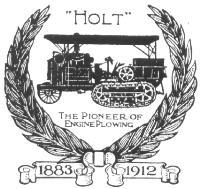
The Holt Manufacturing Company began with the 1883 founding of Stockton Wheel Service in Stockton, California, United States. Benjamin Holt, later credited with patenting the first workable crawler ("caterpillar") tractor design, incorporated the Holt Manufacturing Company in 1892. Holt Manufacturing Company was the first company to successfully manufacture a continuous track tractor By the early 20th century, Holt Manufacturing Company was the leading manufacturer of combine harvesters in the US, and the leading California-based manufacturer of steam traction engines.
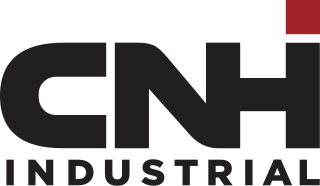
CNH Industrial N.V. is an American-Italian multinational corporation with global headquarters in Basildon, United Kingdom but controlled and mostly owned by the Dutch-Italian investment company Exor, which in turn is controlled by the Agnelli family. The company is listed on the New York Stock Exchange and on Borsa Italiana: it is a constituent of the FTSE MIB index. The company is incorporated in the Netherlands. The seat of the company is in Amsterdam, Netherlands with a principal office in London, England.
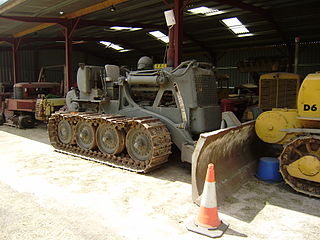
The Vickers VR180 Vigor was a British crawler tractor, built from 1951 to 1958 by Vickers-Armstrongs. During World War II, the company gained substantial experience in the design and construction of tanks and continuous track vehicles. After the war they developed a civilian crawler tractor that could be sold for use in peacetime reconstruction work. It was notable for the unusual sophistication of its chassis.
References
- Caterpillar Chronicle, by Eric. C. Orelmann, pub by MBI, page 65, ISBN 0-7603-0667-2